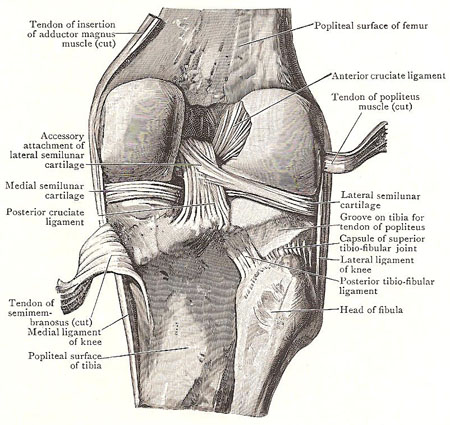cruciate ligaments

Right knee joint opened from behind by removal of the posterior part of the capsule, showing cruciate ligaments are other structures.
The cruciate ligaments are two of the four main ligaments of the knee. They are so called because they cross each other like the arms of the letter X (the Latin crux means "cross"). This X-shaped arrangement is seen whether they are viewed from the side, front, or back of the knee.
The anterior cruciate ligament (ACL) originates in the anterior part of the intercondylar area on the upper surface of the tibia, and proceeds upward, backward, and laterally, to gain attachment to the posterior part of the medial surface of the lateral condyle of the femur.
The term posterior cruciate ligament (PCL) springs from the posterior part of the intercondyle area. It passes upward, forward, and a little medially, and crosses the anterior cruciate ligament obliquely to be attached to the anterior portion of the lateral surface of the medial condyle. It receives one or sometimes two strong slips from the posterior horn of the lateral semilunar cartilage.
The anterior cruciate ligament is tight in extension of the knee
joint, and the posterior in flexion.
Tears or rupture of the cruciate ligaments
Tears or rupture of the cruciate ligaments occur when severe force is applied to the knee joint. The injury is always accompanied by damage to other knee structures; the collateral ligaments are commonly torn, or the capsule may be damaged. The joint cavity quickly fills with blood (hemarthrosis), so that the joint is swollen.
Examination of patients with a ruptured anterior cruciate ligament shows that the tibia can be pulled excessively forward on the femur; with rupture of the posterior cruciate ligament, the tibia can be made to move excessively backward on the femur. Since the stability of the knee depends largely on the tone of the quadriceps femoris muscle and the integrity of the collateral ligaments, operative repair of isolated torn cruciate ligaments is not often attempted. The knee is immobilized in slight flexion in a plaster cast, and active physiotherapy on the quadriceps femoris muscles is started immediately. Should, however, the capsule of the joint and the collateral ligaments be torn in addition, early operative repair is essential.
See also knee disorders.


